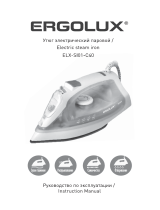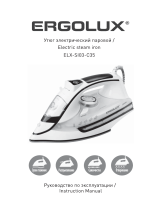
3 Put the mains plug in an earthed wall socket.
, The temperature light goes on (Fig. 6).
4 When the temperature light goes out, wait a while before you
start ironing.
Note: The temperature light goes on from time to time during ironing.
Note: The iron may give off some smoke when you use it for the rst time.
This stops after a short while.
- While you iron, the sensor in the handle ensures that the iron
produces the optimal amount of steam. As 90% of the energy
consumption of an iron is used to create steam, energy consumption
is optimised by optimising the steam output. When you intuitively put
more force on the handle to remove stubborn creases, the iron
automatically produces more steam.
- When you do not press the handle, when you lift the iron and when
the iron is standing on its heel or on its soleplate without any
movement, the automatic energy-saving technology limits the steam
output to reduce energy consumption (Fig. 7).
1 Make sure that there is enough water in the water tank.
2 Set the recommended ironing temperature (see chapter ‘Preparing
for use’, table ‘Temperature and steam settings’).
3 Set the appropriate steam setting. Make sure that the steam
setting is suitable for the set ironing temperature (see chapter
‘Preparing for use’, table ‘Temperature and steam settings’) (Fig. 8).
Note: The iron is ready for steam ironing as soon as it has reached the
set ironing temperature.
Note: If the set ironing temperature is too low (MIN to 2), water may drip
from the soleplate (see chapter ‘Features’, section ‘Drip stop’).
10














